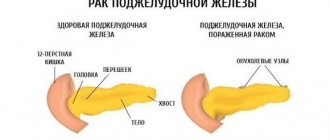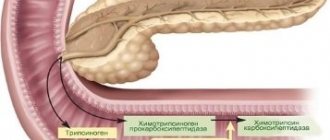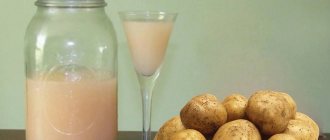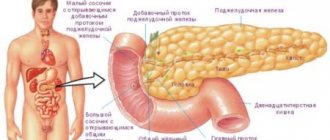Is it possible to treat the pancreas on your own?
Mild to moderate exacerbation of chronic pancreatitis can be treated at home in the following cases:
- You have been fully examined over the past 1-2 years and other diseases have been excluded (eg, tumors, gallstones, peptic ulcers).
- You are well aware of such symptoms of exacerbation and are no different from the past.
- You have previous doctor's recommendations.
- The exacerbation is not severe, without vomiting, without severe diarrhea.
- Within a few days of treatment you notice an improvement.
What medications of other groups are used?
Additionally, medications are used for the pancreas to eliminate the symptoms of the disease and its consequences.
Painkillers and antispasmodics
Various drugs are used to relieve pain: antispasmodics (Platifillin, Atropine, No-shpa), analgesics (Baralgin, Gastrotsepin) and even narcotic drugs in acute cases (Promedol, Tramadol). . They are prescribed by a doctor depending on the type of disease and its stage.
Drugs from the NSAID group (non-steroidal anti-inflammatory drugs) - Butadione, Ibuprofen, Diclofenac and analogues - are not recommended. They irritate the gastric mucosa and can increase pain.
Important. In case of acute pain, you should not take analgesics on your own - they can muffle the symptoms of a developing disease. The doctor will determine how to treat the pancreas.
Antacids
For normal breakdown of food in the duodenum, an alkaline environment is needed. It is supported by bicarbonate of pancreatic juice and bile. With pancreatic insufficiency and impaired bile outflow, alkalization of the acidic contents coming from the stomach does not occur. Antacids are used to neutralize it: “Hilak-Forte”, “Phosphalugel”, “Enterosgel”, “Maalox” and analogues.
Important. You cannot use soda for this purpose. The released carbon dioxide dissolves in the intestinal contents and eventually acidifies it again.
Drugs that neutralize gastric acid are available in a wide range of pharmacies.
Antiemetic drugs
Pancreatitis is often accompanied by nausea and vomiting. To relieve these phenomena, Cerucal, Metoclopramide, and Metukal are used. Their appointment is necessary because frequent vomiting leads to dehydration.
Enterosorbents
When digestion is disrupted, a lot of undigested fiber and toxic substances enter the intestines. This leads to bloating, increased peristalsis, and increased stool frequency. Sorbents remove harmful substances from the intestines and weaken excited peristalsis: activated carbon, Lactulose, Silica gel, Smecta, Polysorb, Polyphepan, Filtrum, Enterosgel.
Sorbents are useful for the treatment of all diseases of the pancreas
Bacterial preparations for the intestines
Good to know. The intestines maintain a balance between pathogenic bacteria and beneficial bacteria that produce vitamins. With indigestion, this balance is disrupted and pathogenic microbes take over, causing an inflammatory process. A condition called dysbiosis develops.
To eliminate it, preparations containing dry spores of beneficial bifidobacteria and lactobacilli are used. Once in the intestines, they “populate” it. By multiplying, they perform their protective function. They are also called probiotics: “Lactobacterin”, “Bifidumbacterin”, “Bifiform”, Acipol”, “Linex” and other products.
Bacterial preparations normalize microflora and intestinal function and are prescribed for many gastrointestinal ailments
Antibiotics
They are prescribed in a hospital setting for acute pancreatitis, pancreatic necrosis, gland abscess, suppuration of a gland cyst, complications - phlegmon, peritonitis, in the postoperative period. Broad-spectrum drugs are used: synthetic ones (Augmentin, Sulbactam), cephalosporins (Cefoperazone, Cefixime and others), macrolides (Rifampicin, Kanamycin). To treat chronic forms of pancreatitis with frequent exacerbations, antibiotics are also prescribed for 5-7 days.
Important. You should not take antibiotics to relieve inflammation without a doctor's recommendation. Choosing them incorrectly can lead to worsening and development of an allergic reaction.
Antihyperglycemic agents
The pancreas plays an important role in sugar metabolism. This function is performed by beta cells in the tail area; they produce the hormone insulin. If there are diseases associated with damage to these islet cells, diabetes mellitus develops. In such cases, the examination is carried out by an endocrinologist, who also selects drugs for correcting blood sugar - tablets or insulin in injections, and determines their dose.
Treatment of the pancreas with certain medications has strict indications. They are determined by the doctor based on the results of the examination. Self-medication with drugs can be harmful.
What is pancreatitis of the pancreas, its signs
Pancreatitis is an inflammatory-degenerative process in the pancreas. Every year the number of people suffering from this disease is growing. Treatment and symptoms of the disease depend on the severity of inflammation and the degree of damage to the pancreas.
The following processes of inflammation of the pancreas are distinguished:
- Acute process. It appears suddenly and requires emergency hospitalization of the patient.
- Chronic process. Its development is most often the result of an acute form.
Increased echogenicity of the pancreas occurs with pancreatitis - Cyst. It appears as a result of inflammatory-destructive processes.
- Pseudocyst is a consequence of a chronic or acute process. It is characterized by the accumulation of large amounts of pancreatic juice near fibrous tissue.
- Steatorrhea. Appears due to chronic gland disease and causes intestinal dysfunction.
In pancreatitis, the causes of inflammation are factors such as:
- Gallbladder disease. This is the main cause of pancreatic disease, since with hypertension in the biliary tract and its reflux, chemical inappropriate processes occur in the pancreas. Damage to blood vessels in the body occurs and swelling is created.
- Stomach diseases. Gastritis and ulcers weaken the functioning of the duodenum. As a result, the process of normal bile release is disrupted. The gland is damaged by its own enzymes, which stagnate in the ducts.
Peptic ulcer is the most common gastrointestinal disease - Diabetes. With this disease, blood circulation in the organ is disrupted, which causes pancreatitis.
- Alcohol and food poisoning.
The disease is also accompanied by the following symptoms:
- severe pain under the left rib;
- vomit;
- high body temperature;
- white coating on the tongue;
- headache;
- high blood pressure.
If you have the above symptoms, you should not hesitate; you should immediately call an ambulance.
| View | Description |
| Colic | Acute pain in the first 2 days has a girdling character in the upper abdomen. |
| Vomit | In the acute course of the disease, it is painful and repeated. May appear along with colic or in later stages. |
| Bloating | The abdomen is inflated, and severe pain appears on palpation. |
| Skin color changes | Pallor and cyanosis of the skin may appear. |
| Breathing problems | The respiratory rate is disrupted due to the loss of electrolytes in the blood during vomiting. A yellow coating appears on the tongue. |
What pills should you take for pain in the pancreas?
Since the pancreas performs a function related to digestion, when it is diseased, changes occur in the functioning of the gastrointestinal tract.
This is extremely dangerous to health and is fraught with unpleasant consequences. Therefore, in case of pathology, drug therapy cannot be avoided.
Tablets for pain in the pancreas are used in the initial stages of treatment, since the first sign of the disease is pain.
Functions of the pancreas and symptoms of its damage
The pancreas is an organ whose role cannot be underestimated. It produces enzymes necessary for digestion and produces a number of hormones. Among hormones, insulin performs an important function, which controls the exchange of glucose in tissues and its level in the blood.
When the gland is dysfunctional, normal digestion of food stops, absorption of nutrients is disrupted, which affects metabolic processes. Pathology may be associated with disturbances in organ development, malignant tumors and the process of inflammation. The last option is the most common.
Important! The clinical picture is related to the cause of the pathology and the acute or chronic stage of development. Symptoms depend on the age of the patient, the speed of metabolic processes, and individual characteristics. It is impossible to make a diagnosis on your own; laboratory tests are needed.
Causes of the disease and symptoms of its manifestation
During inflammatory processes in the tissues of the pancreas, pancreatitis develops, which is accompanied by swelling of the organ, death and disintegration of its tissues. Not only the structure of the gland is disrupted, but also its functions.
The causes of the disease are
- uncontrolled alcohol intake,
- unbalanced diet (abundance of fatty foods and processed foods),
- the presence of gallstone disease,
- disruptions in the hormonal system,
- fasting and the use of diets that are harmful to health.
Pancreatitis can develop against the background of chronic gastrointestinal diseases, abdominal trauma, surgery, and its main manifestation is pain. Pain occurs as a result of swelling or tissue necrosis, inflammation of the peritoneum (peritonitis).
Signs and symptoms of pancreatic disease:
- Dull, stretching or sharp cutting pain, which depends on the strength and nature of the organ damage. The pain does not depend on food intake and increases over time if the patient avoids treatment. If pancreatic necrosis develops, a painful shock occurs, which can lead to death.
- Symptoms of dyspepsia (digestive disorders): loss of appetite, nausea, vomiting, diarrhea. These symptoms appear in the initial stages of the disease and are associated with the use of alcohol or medications.
- Nausea that precedes vomiting. Vomiting accompanies the disease in 80% of cases, but after it there is no relief, which is a consequence of intoxication. At first, he vomits the food he has just eaten, followed by vomiting of bile.
- Dehydration is possible due to frequent vomiting. At the same time, the elasticity of the skin decreases, dry mucous membranes are observed, the heart rhythm is abnormal, and the patient is thirsty. The acid-base balance of the blood is disturbed, acidification of the blood or acidosis occurs.
- Stool instability, which manifests itself as alternating constipation or diarrhea. This is caused by the lack of enzymes in the intestines that are produced by the gland. At first there is bloating and flatulence, then constipation follows and ends with diarrhea. This process is then repeated.
- Skin changes are expressed in pallor or yellowness (due to compression of the bile ducts) of the skin. As a result of intoxication and respiratory disorders, cyanosis is observed: fingers, nasolabial triangle, navel area or other parts of the abdomen, which is associated with changes in blood circulation in the abdominal cavity.
Read more in this article.
Pancreatitis can develop in acute or chronic form. Depending on the form of the disease, symptoms may differ slightly. A clearer clinical picture is observed when the disease manifests itself in the acute stage of development.
Diagnostics
During the initial examination, the doctor performs palpation. Thanks to this simple method, preliminary predictions can be made. If it hurts on the left side under the ribs, this may be due to problems in the pancreas.
Next, laboratory tests are carried out, in which the blood count is most important. The presence of a large number of leukocytes in the blood and an increase in the amylase enzyme in the serum (participates in the metabolism of carbohydrates) indicate an acute stage of pancreatitis. When diagnosing, ultrasound, x-ray, and computed tomography methods are used. They look at the level of enzymes in gastric juice and their ratio.
Features of treatment
In case of dysfunction of the gland and acute forms of the pathology, the patient is hospitalized. He is prescribed drug therapy, which includes
- medications that affect the secretion of gastric juice,
- enzyme preparations to compensate for their deficiency,
- analgesics, which help relieve pain,
- antispasmodics.
But without properly selected food products, treatment is reduced to zero. Therefore, diet plays a primary role in diseases of the pancreas.
What is the effectiveness of tablet forms?
Treatment with tablets has a number of advantages over other dosage forms:
- Passing through the gastrointestinal tract, they are absorbed through the stomach and intestines into the blood, beginning to affect the pancreas.
- Some drugs act directly on the intestines without entering the blood (for example, enzymes).
- The patient can control the intake of tablet forms himself. They can be taken independently at home.
- Tablets do not cause discomfort or pain, such as injections.
Taking medication in tablet form requires consulting a doctor and using it in precise dosages. Moreover, a number of drugs have contraindications and side effects. In addition, among them there are both inexpensive and expensive drugs.
Taking medications
Pancreatitis is not a disease that the body can cope with on its own. And the statement “it will go away on its own” with such a diagnosis is completely inappropriate. Treatment can take place at home or in a hospital based on the severity and extent of the disease.
Therapy should solve the following problems: eliminate pain, normalize the gastrointestinal tract and intestinal microflora, increase the level of enzymes to the desired value, restore hormonal balance. This requires proven and effective drugs that have already “proven” themselves in the fight against pancreatitis.
- Antispasmodics and analgesics - remedies for pain in the pancreas. Antispasmodics help remove spasms from the intestinal muscles. For additional pain relief, mixed types of drugs are used. In acute attacks, the first priority is to eliminate the pain syndrome.
— Means for compensating for enzymatic deficiency are enzymes, due to which gland dysfunction does not have such an effect on the digestive tract. Thanks to them, the functioning of the gastrointestinal tract is normalized, and the possibility of exacerbation of the disease is reduced. Enzymes are divided into:
- products that contain bile: they act effectively, but are not prescribed for gastrointestinal diseases,
- products consisting exclusively of enzymes: they are not taken for a long time, since the dysfunction of the pancreas increases, it ceases to produce enzymes itself.
— Antacids relieve secondary symptoms of the disease. Typically, with pancreatitis, an excess amount of hydrochloric acid is produced in the stomach, to neutralize which anticides are used. By reducing acidity, the destruction of enzymes is reduced.
— Antisecretory drugs have an analgesic effect, reduce the production of hydrochloric acid, and relieve abdominal syndrome. They are usually prescribed for chronic disease.
Important! When the pancreas hurts, there is general intoxication, impaired intestinal motility, nausea and vomiting. All these symptoms are also relieved with the help of medications during medical therapy.
Treatment of pancreatitis during pregnancy is not an easy task. Relief of the condition is based on minimal medication and maximum use of dietary nutrition with limited fat intake, increased protein, vegetables and fruits in the diet. Antispasmodics are used to relieve pain; the choice of enzymatic preparations is small. The main treatment is prescribed after the birth of the child.
Medicines for pancreatitis and the course of treatment are prescribed by the doctor, based on the patient’s condition and examination results. It is important to complete the course of treatment so that the disease does not smoothly develop into a chronic form.
Use of homeopathic remedies
Homeopathy is widely used today in the treatment of various diseases. This form of treatment is based on the principle of similarity: if in large doses a drug can cause a disease, then in small doses it can cure it. This method of dealing with an illness can be treated differently, but it should not be ignored.
Homeopathy for the pancreas recommends a number of remedies aimed not only at relieving the disease, but also at recovery. For example:
- "Apis" helps well during exacerbations, relieving inflammatory processes;
- “Nux Vomica” normalizes the level of bile and its movement through the intestinal tract;
- "Lycopodium" is used for stagnation of bile;
- “Iris Versicolor” relieves pain by acting directly on the pancreas and is one of the best remedies.
After the exacerbation is stopped, all these homeopathic remedies can continue to be used by changing the degree of dilution and creating less concentrated solutions.
Important: When treating diseases of the pancreas, folk remedies are used that are quite effective, for example, kryphei moss, which relieves attacks of nausea and pain (it is expensive). There are many recipes available to everyone from herbs in central Russia, which are used in parallel with drug therapy.
Diet for pancreatitis
Nutrition in diseases of the pancreas is given paramount importance. The main emphasis should be on protein foods, reducing the content of carbohydrates and fats in the diet. The use of fried foods and coarse fiber is unacceptable. You should organize 5-6 meals a day, that is, eat food in small portions, but often.
What to do during an exacerbation of the disease? Drink mineral water or just water, rosehip decoction in large quantities (5-6 glasses a day).
Water removes toxic compounds and partially relieves pain. Fasting is recommended for the first two days of exacerbation.
Then the patient is offered a low-calorie diet, from which fats, salt, spices, and any dishes that promote the secretion of gastric juice are excluded.
During the period of subsiding exacerbation, it is necessary to take into account the mechanical and biochemical composition of dishes so that they do not irritate the intestinal mucous membranes. The diet uses diet No. 5. She assumes
- balance of vital substances: proteins, fats, carbohydrates;
- the presence of water- and fat-soluble vitamins in food;
- ban on salty, spicy, smoked and spicy foods.
Food is steamed. The patient uses it in crushed and pureed form. Dishes should be warm, but not hot. Portions are offered in small sizes so as not to increase the load on the gastrointestinal tract.
Important! Dietary nutrition for acute forms of the disease is prescribed from six months to a year. Recovery depends not so much on medications that stop the pathology, but on proper nutrition based on the advice of a doctor. In the chronic form, table No. 5 is recommended for life for the patient.
Useful foods for normal pancreas function:
- stewed or boiled vegetables,
- vegetable soups,
- meat, fish, poultry only in lean form,
- milk or water-based porridges,
- non-sour dairy products, steamed cottage cheese casseroles,
- lightly dried wheat bread,
- limited - jam or honey (several spoons per day),
- Drinks include jelly, compote, and weakly brewed tea.
You will need to completely exclude the following drinks from your diet: alcohol, sweet juices and carbonated drinks, coffee and cocoa. Lard and cooking fats are not allowed. You will have to give up confectionery, chocolate and ice cream. Eggs in any form are not allowed. And lovers of figs, grapes, bananas and dates will have to forget about them.
Read more about healthy foods for the pancreas here.
We looked at pancreatic disease using the example of pancreatitis. There are other equally dangerous pathologies of this organ. To avoid them, try not to wait for pain and the arrival of an ambulance, but eat right and think through your daily menu. This is the key to your well-being today and hope for a healthy future tomorrow.
Source: https://pdoctor.ru/podzheludochnaya-zheleza/tabletki-ot-boli.html
Principles of treatment of chronic pancreatitis
- A diet excluding fatty foods, smoked meats, rich broths, and canned food. This restriction in case of pancreatic diseases is observed for life. In case of exacerbation, fasting is prescribed for several days, and then a low-fat diet until the inflammation subsides.
- Quitting alcohol and smoking.
- Reducing pain.
- Decreased secretion of digestive juices during exacerbation of the pancreas.
- Taking enzyme tablets to support digestive processes.
- Relieving spasms and normalizing intestinal motility.
- Taking vitamins and minerals, since their absorption from food is impaired during pancreatitis.
- Medicines to restore intestinal flora.
- Treatment of diabetes mellitus, which can be a complication of acute or chronic pancreatitis.
Treatment for pancreatitis is complex and depends on the symptoms. There are no universal “good pills for the pancreas.” The disease can progress in different ways. One will have pain and need pain medication, the other will have malabsorption and digestion problems and need more enzyme medications. Some people may experience pain and diarrhea, accompanied by weight loss and exhaustion.
Medications
Medicines are an essential component of therapeutic therapy and prevention. Taking them allows you to get rid of pain of various types, normalize the function of the gland, improve the absorption of nutrients, and compensate for endocrine insufficiency. The following drugs are used in medicine to treat the pancreas:
- Mild analgesics, antispasmodics. These may be Baralgin, No-shpa, Papaverine. They are excellent pain relievers, but have a temporary effect.
- Enzyme medications designed to normalize digestion and facilitate the digestion of food. They also help reduce pain by reducing the load on the gland. These are: Pancreatin, Festal, Mezim.
- Antacids. Medicines are used in cases of disruption of the exocrine function of the gland and are necessary to suppress the production of hydrochloric acid. These are: Almagel, Maalox, Omeprazole.
- Additional drugs for symptomatic therapy. To restore normal functioning of the body, choleretic (Allohol), sedatives, medications for diarrhea, intoxication, vitamins, and hormones can be prescribed.
Complications
Chronic pancreatitis, which occurs over a long period of time, affects all systems and organs. Its complications often include liver damage, morphohistological changes and complications of a purulent-inflammatory nature.
In the acute course of the disease, intoxication and pain are combated. In addition, specialists prescribe a course of antibiotics.
The patient during and after treatment must adhere to a diet, quit smoking and alcohol and follow all doctor’s recommendations, as well as treat concomitant gastrointestinal diseases in a timely manner. Periodic spa treatment can also be a good help in avoiding exacerbations.
Why are enzyme and anti-enzyme drugs needed?
The main function of the pancreas is the production of enzymes that break down proteins, fats and carbohydrates; without this, their absorption from the intestines is impossible. With diseases of the gland, its enzymatic function may decrease, which happens with chronic pancreatitis, degenerative phenomena in the parenchyma - fibrosis, lipomatosis. Digestive disorders develop, the function of the stomach, liver, and intestines is disrupted. In such cases, replacement therapy with enzyme preparations is prescribed, which normalize the digestive process.
On the other hand, the function of the gland can be increased, with excessive formation and activation of enzymes, for example, in acute pancreatitis, trauma, and some types of tumors.
Important. An excess of enzymes leads to the fact that they begin to digest gland tissue and destroy it. In addition, a high concentration of enzymes in the blood leads to intoxication of the body and disruption of the functioning of other organs.
In these cases, enzyme antagonists (inhibitors) are prescribed.
Enzyme preparations for the pancreas
The group of these drugs includes such drugs as “Pancreatin”, “Mezim”, “Panzinorm”, “Licreaz”, “Enzibene”, “Creon” and analogues. They contain a full range of essential digestive enzymes. There are products that also contain bile acids, which perform the function of activating enzymes in case of bile duct disease. These include: “Festal”, “Ferestal”, “Enzyme”, “Digestal”, “Enzistal”. All of them are used during meals.
The choice of enzyme preparations and their dosage is determined only by a doctor.
Anti-enzyme drugs (inhibitors)
This group includes: “Kontrikal”, “Gordox”, “Trasilol”, “Ingitril”, “Pantripin”, “Antagozan” and analogues. These drugs inactivate enzymes that break down proteins. They are used for acute pancreatitis, when an excess of gland enzymes leads to the destruction of the protein of its own tissue (self-digestion).
Enzyme inhibitors are administered intravenously in a hospital setting
The main groups of drugs used for pancreatitis
The main symptom that torments a person during exacerbation of pancreatitis is pain. What pills should you take if your pancreas hurts?
- The main painkiller that can be taken for inflammation of this organ is Paracetamol (it is the least safe for the gastric mucosa). Paracetamol is taken 1-2 tablets 3-4 times a day 30 minutes before meals. However, it is prescribed with caution for concomitant liver pathology.
- It is also possible to use short courses of other non-narcotic analgesics - Spazgan, Baralgin, Ketanov, Ibuprofen, Nimesulide. There are studies confirming the enhanced analgesic effect of these drugs when taken together with multivitamin complexes, as well as with antidepressants (amitriptyline).
Painkillers should not be taken for more than 10 days.
- Antispasmodics are also used - No-shpa, Buscopan, Mebeverine, Duspatalin, Papaverine. They relieve spasm of the bile ducts and intestines, thereby reducing the pressure in the intestinal lumen.
- The more acidic the contents come from the stomach into the duodenum, the more secretion in the pancreas is activated. Accordingly, drugs that suppress the secretion of hydrochloric acid also indirectly relieve pain. These medications include H2 receptor blockers Ranitidine, Famotidine, as well as proton pump inhibitors Omeprazole (Omez, Losek, Ultop), Rabeprazole (Pariet), Pantoprazole (Nolpaza, Contraloc), Esomeprazole (Nexium).
- Sometimes the antisecretory drug Dalargin is used for intramuscular or intravenous administration.
- Antacids - Phosphalugel, Maalox also reduce the acidity of gastric juice. They are used 40 minutes after meals and before bedtime.
Enzymes
The pancreas is the most active gland in our body. It produces 1.5-2 liters of pancreatic juice per day containing 10-20 grams of digestive enzymes. A chronic inflammatory process almost always leads to a decrease in their number, which affects the digestion of food (mainly fats).
Undigested food remains are not absorbed in the intestines and cause fermentation, bloating, and diarrhea (malabsorption syndrome). Distended intestinal loops further aggravate abdominal pain; malabsorption leads to weight loss, anemia and hypovitaminosis.
Therefore, the main medications for pancreatitis during exacerbation are enzymes that help normal digestion and absorption of food. Indirectly, they also reduce pain, normalize stool, prevent exhaustion and promote the absorption of vitamins and minerals in the intestines.
Enzyme preparations are available both in tablet and capsule form. Each form has its own advantages and disadvantages. The list of tablets that contain digestive enzymes is large. They all contain amylase, lipase and protease in varying dosages, plus other additives.
- The cheapest enzyme preparation is our domestic Pancreatin. But it is a stretch to call it a cure for pancreatitis, since it has a low concentration of active enzymes (in terms of lipase - about 3 thousand units). It is used more for errors in diet. One of the advantages is the low cost (starting from 30 rubles).
- Pancreatin analogue – Mezim. Activity is about 3500 IU of lipase. The cost is about 100 rubles for a package of 20 tablets.
- Penzital (about 6000 units of lipase). Price – from 170 rubles.
- Enzistal P (3500 units). Price from 70 rubles.
- Panzim forte (3500 units). Price from 160 rubles for 20 tablets.
If we talk about proper treatment, then when the pancreas hurts, medications should be chosen with a higher concentration of enzymes. The focus is mainly on lipase content. For normal replacement therapy, you need at least 25,000-40,000 units of lipase per main meal and about 10 thousand units for additional snacks.
- The most famous tablets for the pancreas with enhanced activity are Mezim-Forte 10000, 20000. Prices for these drugs start at 200 rubles per pack of 20 tablets.
The most effective enzyme medications today are considered to be pancreatin preparations in the form of microtablets, minimicrospheres or microplates enclosed in a gelatin capsule (IV generation). The diameter of pancreatin particles in such a capsule is no more than 2 mm. The shell itself dissolves not in the stomach, but in the duodenum, the particles are evenly mixed with food, the effect of this form of enzyme use is maximum.
The pancreas hurts, what medications to take: what to drink, what to do, how to relieve pain
If your pancreas hurts, what medications to take is a difficult question. The fact is that the organ responsible for processing food and synthesizing hormones is subject to changes leading to diabetes, cystic fibrosis, pancreatitis and the development of tumors.
Therefore, making an independent selection of medications is dangerous due to the risk of developing complications of existing pathologies.
Medicines to help the pancreas are selected by a specialist taking into account the cause of the disease and its symptoms, for example, pain, nausea, cramps.
Painkillers and antispasmodics
All diseases of the pancreas cause severe pain in the epigastric zone and the area of the left lower rib. The discomfort may spread to the chest or lower back. For pain in the pancreas, in most cases the following is prescribed:
- Diclofenac;
- Analgin;
- Baralgin.
Individual selection of the drug and its dosage is necessary so as not to aggravate the patient’s condition.
Inflammation of the pancreas often leads to spasms of the bile ducts. In such cases, taking painkillers alone is not enough. Patients are prescribed antispasmodics:
- No-shpa. This is one of the most popular antispasmodics. With its help, it is possible to anesthetize the pancreas for a long time. It should be remembered that treatment with the drug for more than 3 days can be dangerous!
- Drotaverine. A cheap analogue of No-shpa with the same active ingredient in the composition.
- Buskopan.
- Papaverine.
- Duspatalin. The drug is prescribed after 3 days of intensive therapy with a stronger drug.
Painkillers and antispasmodics are not able to relieve the cause of pain in the pancreas. They are prescribed as an adjuvant as part of general drug therapy.
Drugs in this group have an aggressive effect on the digestive system, so we recommend that you consult your doctor to select the safest drug, determine the dosage and duration of use.
What foods are good for the pancreas?
Enzyme products
To restore the pancreas, drugs with digestive enzymes are prescribed. Creon is rightfully considered the best representative of this group, but its use is not possible in all cases.
It all depends on the body’s reaction to the drug, general condition, and how advanced the disease is.
The data from the hardware and laboratory examination of the patient allow the gastroenterologist to select the correct dosage and course of treatment.
If indicated, the following drugs may be prescribed:
- Panzinorm.
- Pangrol.
- Pancreatin.
- Festal.
- Enzyme Forte.
- Mezim Forte.
- Ferestal.
Experts give preference to drugs containing pancreatin. This substance is a successful combination of protease, amylase, lipase. Enzymes promote quick and easy digestion of carbohydrates and proteins. Fiber also undergoes active breakdown. Thanks to high-quality processing, all elements are successfully absorbed in the small intestine.
Taking medications with the specified active substance helps to normalize the exocrine function of the pancreas.
It is important to consider that the course of treatment may take several months. It all depends on the degree of neglect of the pathology. For chronic pancreatic diseases, Festal is most often prescribed. In especially severe cases, the patient has to stop taking pills only during an exacerbation of the pathology.
In cases where inflammation of the pancreas is accompanied by additional swelling, the attending physician may prescribe a course of antienzymes. These include Kontrikal and Gordox.
Additional drug therapy to alleviate the patient’s condition
Taking medications does not provide a complete and high-quality cure.
If the patient neglects the doctor’s recommendations about creating a menu and changing lifestyle, the patient’s condition will not change for the better.
Enzyme therapy and painkillers provide the desired result only against the backdrop of a strict diet and complete abstinence from the consumption of alcohol, nicotine, narcotic substances,
What is pancreatic steatosis
The list of medications for pancreas restoration can be expanded to include:
- Sedative drugs.
- Antihistamines and choleretic drugs.
- Preparations containing calcium.
- Vitamin complexes and enveloping medicines.
- Hormonal drugs.
In rare cases, pancreatitis may be accompanied by an infection. To protect the pancreas, antibacterial drugs with a broad spectrum of action are prescribed:
- Tobramycin;
- Carbenicillin;
- Ampicillin.
To prescribe any of the drugs in this group, a preliminary laboratory test is required. It is carried out to determine the type of infectious agent and its sensitivity to various antibiotics.
Analgesics provide temporary relief from pain; complex therapy allows you to completely get rid of it. Enzyme preparations and a strict diet are necessarily accompanied by a parallel course of taking antacids with secretion inhibitors. These drugs help neutralize hydrochloric acid. The most popular drugs are Ranitidine and Maalox.
Maalox is allowed to be taken after the acute condition has been relieved. The medicine contains aluminum and magnesium hydroxide. It provides not only neutralization of hydrochloric acid, but also an adsorbing, enveloping effect. To avoid complications, prior consultation with your doctor is recommended before starting treatment.
In some cases, a full course of treatment is necessary, in others, it is enough to take the medicine 2-3 times.
When trying to get rid of pain in the pancreas caused by the development of tumors, in the early stages of the pathology, a combination of painkillers and antiseptic drugs is used. Advanced cases cannot be treated with medication. The pain that occurs is dealt with through surgery.
How long do people live with stage 4 pancreatic cancer?
Natural medicines
Natural products containing a large number of biologically active substances can become a replacement or a successful addition to the medications of the main course of drug therapy.
In childhood, with intolerance to certain groups of drugs, during pregnancy and lactation, many drugs are contraindicated.
In this case, natural medicines remain the only way to cope with pancreatic pathologies.
Propolis is characterized by a high content of vitamins, minerals and active organic components. Regular intake of propolis 3 times a day helps stabilize the secretory activity of the pancreas. It is possible to restore internal organs with the help of honey, which is eaten 1 tbsp. on an empty stomach.
To combat the manifestations of pancreatitis, it is recommended to drink 100 g of potato juice before meals. For its preparation, only peeled good quality tubers are used. Potato juice quickly loses its beneficial properties, so it must be drunk immediately after preparation.
Oatmeal broth helps get rid of the negative effects of taking chemicals on the digestive system. To obtain it, pour 1 glass of oats into 1 liter of water and leave for 10-12 hours.
Then cook over low heat for 30 minutes, remove and put in a dark place for 6 hours. After straining, the liquid is stored in the refrigerator. It is recommended to drink the medicine 3 times a day before meals.
Treatment of pancreatic pathologies requires complex therapy. The patient needs not only to get rid of unpleasant symptoms, but also to prevent their reappearance in the fastest and safest way possible.
Source: https://MedicalOk.ru/podzheludochnaya/bolit-zheleza-kakie-lekarstva-prinimat.html
Diagnostics
Diagnosis of pancreatitis is a complex and multi-stage process, which includes collecting complaints and conducting laboratory tests. Such a variety of diagnostic methods is necessary in order to make an accurate diagnosis. After all, pancreatitis can occur under the guise of diseases of other organs. Therefore, a comprehensive examination of the patient is required.
This examination is prescribed to all patients with pancreatitis of the pancreas. Ultrasound is a high-quality and highly informative study. All other research methods are not highly effective.
This study is often prescribed when complications occur. X-rays allow you to examine the organ in detail, assess the extent of its damage and determine the amount of healthy and fatty tissue.
An endoscopic examination is carried out using a special probe, which is inserted into the main duct and an x-ray is taken. With the help of such an examination, the patency of the ducts is assessed. During the examination, small stones that are excreted naturally can be removed. This method is minimally invasive, which is why many people prefer it.
Preparations for restoring intestinal microflora
How else can you help the pancreas? Having relieved the pain attack and observing dietary restrictions, the patient begins to take medications that promote the production of special enzymes. They are needed to facilitate the process of digesting food and assimilation of its components by the body.
Restoration of the pancreas can be started by taking Festal. These tablets are available in almost any pharmacy. The drug contains components that facilitate the digestion of food and relieve stress on the glands and other organs involved in the process. The dosage of the drug is usually indicated in the accompanying instructions.
Festal
A drug with a more pronounced effect is Pancreatin. This drug is an enzyme product; it contains components that help the internal organs absorb proteins, carbohydrates and fats released during the digestion of food.
The number of tablets usually taken with food depends on the severity of the disease and the duration of the disease. The course of taking the drug also depends on this. Tablets are taken from 1 week to 1 month. It is important to note that it is better to discuss taking Pancreatin with your doctor.
A similar effect is exerted by the drugs Mezim and Creon, which also promote the absorption of food and relieve stress on the pancreas. Their dosage can be found in the attached instructions.
All of the tablets listed above help the body improve digestion. And like any medications, they can cause side effects. Their strength and duration depend on the personal tolerance of the components that make up the drug.
Experts note that these drugs have a strong effect on the body, so they should not be abused. When treating pancreatic inflammation, it will not be possible to quickly get rid of the disease with a loading dose of tablets. This can only harm yourself.
Therefore, it is strongly recommended that at the first signs of illness, you visit a doctor and get advice from him, including on taking medications.
An imbalance in the ratio of normal and pathogenic bacteria in the intestines is observed in almost all patients with chronic pancreatitis. This is explained by a lack of enzyme secretion and increased fermentation processes, which creates a favorable environment for the proliferation of pathogenic microflora.
To eliminate this phenomenon, the following are sometimes prescribed:
- Intestinal antibiotics: Enterofuril (Stop-diar), Rifaximin (Alfanormix). Or Ciprofloxacin, course for up to 7 days.
- Then - probiotics and prebiotics containing normal beneficial bacteria. These include: Baktistatin, Enterol, Linex, Bifiform, Floristin, Normobact, etc. They are taken during or after meals in courses of up to 3 weeks.
What medications to take if your pancreas hurts?
When health problems arise and the pancreas hurts, victims are interested in what medications to take to relieve pain and treat the pathology.
To answer the question, you need to understand the cause of the pain, since there are parallel diseases that accompany the disease - pancreatitis, in which some types of medications may not help, but complicate the course of the disease. Such diseases include:
- diabetes;
- renal failure;
- other serious diseases of human internal organs.
In any case, it is necessary to undergo a complete diagnosis of the body and determine the exact diagnosis and type of pancreatitis, and, if possible, identify the cause of the disease that provoked an acute attack and pain syndrome.
Treatment of pancreatitis consists of a sequence of actions and depends on the form of the course, whether acute or chronic.
Each type requires individual treatment and approach, and pain relief requires consultation with a gastroenterologist.
Classification of drugs
N-2 blockers
The activity of this group of drugs is aimed at counteracting gastric secretion. Such agents block H-2 receptors, suppress the formation of hydrochloric acid, relieve irritation of gastritis and acetylcholine.
Anticholinergics
A group of drugs helps eliminate pancreatitis. They facilitate the action of acetylcholine. If the disease is already chronic, then it needs to be treated with m-anticholinergic drugs. Drugs in this group block pathological impulses in the nerves and cerebral cortex.
Antacids
Antacids are medications whose action is aimed at removing hydrochloric acid. They are prescribed to patients who have high stomach acidity. When the formation of hydrochloric acid is high, the products produce a pancreatic enzyme. These drugs reduce the secretory function of the stomach.
Antispasmodics
Medicines that eliminate spasms are used in cases of impaired motor function of the gastrointestinal tract. Such failures appear due to a decrease in the tone of the sphincter of the pancreatic duct.
Enzymes
Enzymes include protease, amylase, and lipase, which are needed to break down food. They support the proper functioning of the pancreas, normalize digestion and stimulate the digestion of proteins and carbohydrates.
Pancreatitis
The pancreas is part of a single functioning system of the gastrointestinal tract. Any negative factors affecting the gland negatively affect its functioning. However, without the necessary enzymes produced by this organ, complete breakdown of food and further absorption of nutrients is impossible.
Pancreatitis undoubtedly takes precedence among the most common diseases affecting the pancreas. Without taking any therapeutic action, acute pancreatitis has a great chance of developing into a chronic disease. At the same time, during drug treatment, the first place should be a complete review of the diet and food intake.
Treatment of acute pancreatitis
If the pancreas is acutely inflamed, oral medications will not help. Inpatient treatment is required here. The patient will be prescribed:
- Intravenous infusions of physiological solutions.
- Pain relief up to narcotic analgesics.
- Proteolytic enzyme blockers - Gordox, Kontrikal.
- Octreotide is a medicine to suppress gland secretion.
- Antibiotics.
- Antiemetics.
- Surgery if conservative measures are ineffective.
Top 10 drugs from the pharmacy
Medicines for pancreatitis of the pancreas make the patient feel better and prevent the development of adverse consequences.
Mezim is a digestive enzyme agent that replenishes their deficiency and has a lipolytic effect. The drug contains enzymes amylase, protease, lipase, which normalize the digestive process and improve fat absorption.
Enzymes have a compensating effect and replenish the own pancreatic enzymes. The product provides lipolytic and pharmacological effects. Trypsin, which is part of the composition, suppresses the secretion of the pancreas. Maximum activity is observed 30 minutes after using the drug.
Indications:
- chronic intestinal diseases;
- chronic pancreatitis;
- intestinal infections;
- frequent consumption of fatty foods;
- preparation for ultrasound of the gastrointestinal tract.
The drug is prescribed before meals, the dosage depends on the age of the patient. The usual dose is 1-2 tablets Mezim 10,000. For adults, the average dosage is 150,000 units/day. The course of therapy lasts from several days to several months.
Contraindications:
- allergy to substances in the product;
- acute pancreatitis;
- exacerbation of chronic pancreatitis.
https://www.youtube.com/watch?v=Tdx7evAVjqY
The product is available without a doctor's prescription, costs from 80 rubles.
Maalox
An antacid drug containing magnesium hydroxide and algeldrate. The product is produced in chewable tablets and suspension for oral administration. The active ingredients of the drug are considered antacids and are almost not absorbed during use and do not have systemic effects.
The medicine has an enveloping effect, due to which the effect of damaging factors on the lining of the stomach and esophagus is reduced.
Indications:
- stomach ulcer;
- chronic gastroduodenitis;
- hiatal hernia;
- dyspeptic phenomena.
Contraindications:
- age up to 15 years;
- intolerance to maltitol;
- allergy to drug substances;
- hypophosphatemia.
The drug is prescribed 2 tablets 3 times a day 3 hours after meals. The course of therapy should not exceed 2 months. The product is sold without a prescription and its price starts from 125 rubles.
Meteospasmil
Combination medicine for the treatment of gastrointestinal disorders. Its active ingredient alverine reduces the high tone of intestinal smooth muscles at the cellular level and relieves muscle spasms.
Simethicone, which is part of the product, reduces gas formation in the intestines and protects the walls of the gastrointestinal tract with a film. The drug Meteospasmil is used for the symptomatic treatment of intestinal disorders that are manifested by flatulence. The product is used orally, 1 capsule 2 or 3 times a day. The duration of therapy is determined by the doctor individually.
Contraindications:
- allergy to the active ingredients of the product;
- intestinal obstruction;
- gastrointestinal diseases.
The product is sold in pharmacies without a doctor's prescription and costs from 440 rubles.
Baralgin
Medicines for pancreatitis of the pancreas, such as Baralgin, are an antipyretic and analgesic and belong to the group of non-steroidal drugs. The medication is produced in tablets and its main active ingredient is metamizole sodium.
The product also contains additional substances: magnesium stearate and macrogol. The product has an anti-inflammatory and antipyretic effect. The drug is quickly absorbed from the gastrointestinal tract and dissolves in the liver to a metabolite. The drug is excreted by the kidneys.
Indications:
- mild pain of various origins;
- pain after diagnosis;
- fever;
- spasm.
Contraindications:
- bronchial asthma;
- hepatic porphyria;
- age up to 15 years;
- allergy to substances in the product;
- pregnancy.
The daily dosage for adults is 1-2 tablets 2-3 times a day. The duration of treatment should be no more than 3-5 days. The drug is available with a prescription, and its price starts from 190 rubles.
Movalis
The medicine for pancreatitis Movalis has an analgesic and anti-inflammatory effect in the treatment of the pancreas. The drug is produced in tablets, suspensions, and rectal suppositories. The product contains meloxicam, magnesium stearate, lactose monohydrate.
Indications:
- rheumatoid arthritis;
- osteoarthritis;
- ankylosing sponzilitis.
Contraindications:
- bronchial asthma;
- active gastrointestinal bleeding;
- liver failure;
- age up to 12 years;
- pregnancy.
The drug is best taken before eating. The drug is prescribed 1 pc. 1 time per day. The medicine is sold by prescription and its price starts from 600 rubles.
Indomethacin
An anti-inflammatory non-steroidal drug with an antipyretic effect. The product is produced in the form of tablets, suspensions, rectal suppositories, ointments, and gels. The active substance of the drug is indomethacin, additional potato starch, propylene glycol, povidone.
Indications:
- articular syndrome;
- osteochondrosis;
- rheumatism;
- inflammation in soft tissues.
Contraindications:
- exacerbation of gastrointestinal inflammation;
- hypocoagulation;
- pregnancy;
- age up to 14 years;
- allergy to the drug.
The drug is prescribed after meals, 2-3 tablets 3 times a day for 4 weeks. The medication is available with a prescription, and its cost is from 95 rubles.
Cerucal
An antiemetic drug containing the active substance metoclopramide hydrochloride. The product reduces nausea and stimulates the digestive tract.
Indications:
- nausea;
- gagging;
- hiccups;
- gallbladder disease.
Contraindications:
- intestinal obstruction;
- bleeding from the gastrointestinal tract;
- lactation;
- pregnancy;
- gastric perforation.
The medication is taken 10 mg 3-4 times a day. Cerucal is sold without a prescription and costs from 240 rubles.
Metoclopromide
Medicines for pancreatitis include antiemetics such as metoclopromide. They are used for vomiting of various origins. The medication eliminates hiccups and nausea, regulates the functions of the gastrointestinal tract, and enhances its motor activity.
After using the medicine, the secretion of bile is normalized, ulcers in the stomach and duodenum heal. The drug stimulates the production of prolactin and is quickly absorbed from the stomach. It begins its action after 3 minutes. Produced in tablets, suspension for children and solution for injections.
Indications:
- radiation therapy;
- liver diseases;
- traumatic brain injuries;
- errors in nutrition.
Contraindications:
- allergy to substances in the product;
- epilepsy;
- intestinal colic;
- pyloric stenosis;
- age up to 2 years;
- pregnancy.
The drug is used 30 minutes before meals, 10 mg 3-4 times a day. Duration of treatment is 4 weeks. The product is sold in pharmacies with a prescription and its price starts from 149 rubles.
Polysorb
Polysorb is a multifunctional intensive sorbent. It is universal as it binds and removes harmful toxins from the human body.
The product has a large sorption capacity, due to which it binds 3 times more toxins. It is used as a complex therapy for almost any pathology.
The medicine is produced in powder for making a suspension. Its active component is colloidal silicon dioxide.
Indications:
- any intoxication;
- poisoning;
- allergy.
To make the medicine, you need to shake the required amount of powder in 100 ml of water and drink quickly. Adults should take 6-12 g of powder.
Contraindications:
- ulcer;
- stomach bleeding;
- intolerance to Polysorb.
The product is sold without a prescription and its price starts from 110 rubles.
Regidron
Medicines for pancreatitis of the pancreas, such as Regidron, have rehydration and detoxification effects. The drug is produced in powder for the preparation of a suspension. Includes active substances: Dextrose, sodium chloride, sodium citrate.
Indications:
- correction of acidosis;
- prevention of water-electrolyte imbalance;
- rehydration therapy for diarrhea.
Contraindications:
- unconscious state;
- kidney dysfunction;
- diabetes;
- allergy to substances in the product.
The contents of 1 package are filled with 1 tbsp. boiled water and drink every 5 minutes, once a day. The product is sold in pharmacies without a prescription and its price starts from 400 rubles.
Antibiotics and analgesics for pancreatitis
The pathology of the pancreas is not infectious in nature, but in some cases it may be accompanied by bacterial damage. According to most experts, the optimal solution would be drugs with a wide range of antibacterial and antibiotic effects:
It is important to remember that the decision to prescribe medications that have an inhibitory effect on pathogenic microorganisms must be accompanied by additional laboratory and clinical studies to determine the degree of sensitivity of the bacteria. In addition, these medications can cause an allergic reaction and have some contraindications (impaired liver function, lymphocytic leukemia, and others).
If the pancreas hurts for a long time and the pain intensity does not decrease, analgesics are most often used:
Meanwhile, it is advisable to take them by intramuscular injection rather than orally. If the pain syndrome subsides, you can switch to taking tablets, dosing one or two to 3 times a day.
To prevent the onset of pain shock during high-intensity pain, doctors can prescribe analgesic drugs:
In conclusion, it is worth paying attention to the fact that pancreatitis cannot be treated quickly. The disease can be cured by long-term complex treatment with medications containing sufficient amounts of enzymes.
The abdominal cavity contains a small but important organ - the pancreas. It is responsible for the production of enzymes involved in digestion, produces hormones, and regulates metabolic processes. If functions are impaired due to something, negative consequences are possible. Find out how to cure your pancreas in different ways.










